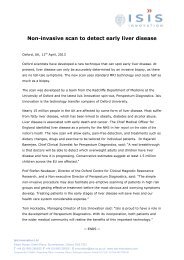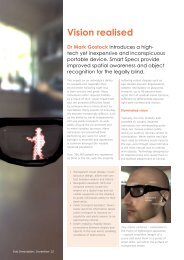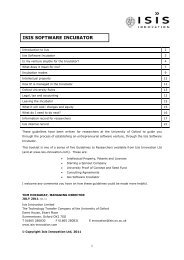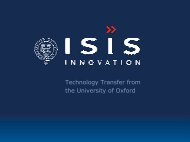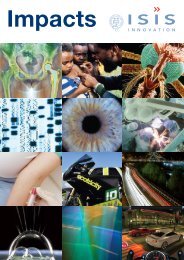CLIMATE CHALLENGE - Isis Innovation
CLIMATE CHALLENGE - Isis Innovation
CLIMATE CHALLENGE - Isis Innovation
- No tags were found...
You also want an ePaper? Increase the reach of your titles
YUMPU automatically turns print PDFs into web optimized ePapers that Google loves.
NewsReviewing the latest innovations,collaborations and technology transferEdition 55 WiNTER 2008<strong>CLIMATE</strong> <strong>CHALLENGE</strong>
<strong>CLIMATE</strong> <strong>CHALLENGE</strong>Tom HockadayIn its early days, <strong>Isis</strong> Newsreproduced the lecturesdelivered at Oxford <strong>Innovation</strong>Society meetings to thoseMembers who had been unableto attend. Over the years<strong>Isis</strong> News has developed tofeature the Members of theOIS, technologies availablefor licensing, examples ofsuccessful licensing deals, andTom Hockaday, Managingspin-out company activities.Director, <strong>Isis</strong> <strong>Innovation</strong> Ltd.Most recently we have beenable to include features on our consulting activities withOxford University Consulting and <strong>Isis</strong> Enterprise.The Oxford <strong>Innovation</strong> Society meeting in September heardtwo lectures from distinguished speakers. Professor PeterEdwards, FRS, Inorganic Chemistry Laboratory at Oxford,spoke about the technological challenges in the battleagainst climate change. Dr Murali Sastry, Chief ScientificOfficer of Tata Chemicals Ltd based in Pune, described thenetwork of global businesses that make up the Tata Group,and Tata Chemicals activities, involved in producing salts andfood additives.This edition describes these lectures, and contains manyother fascinating pages on technology profiles, successfuldeals, spin-outs, consulting relationships and our businesspartners.As always, please let me have your comments, and pleaseregister to receive E-News and Technology Updates atwww.isis-innovation.com/new/newsYoursTom Hockaday, Managing DirectorContentsNews and events 3Professor Peter Edwards 4Academic Speaker – Oxford <strong>Innovation</strong> Society Seminarand Dinner September 2008Tata Chemicals Limited 5Sponsor for Oxford <strong>Innovation</strong> Society Seminar and DinnerAccelerating Progress 6OIS Member: Camitri Technologies Ltd<strong>Isis</strong> licenses pH sensor technology to 7Phathom Nanosensors IncOxford invention licensed to US companyOxford signs deal to develop world’s 8leading TB vaccineOxford-Emergent Tuberculosis ConsortiumEnzyme cofactor regeneration 9<strong>Isis</strong> Project Number 3387Improvement of heart by-pass operations 10<strong>Isis</strong> Project Number 2531Smart active microwave cavity sensors for 11medical and non-medical applications<strong>Isis</strong> Project Number 3152Higher efficiency materials for Li ion batteries 12<strong>Isis</strong> Project Number 2918MRI image improvement aids diagnosis 13<strong>Isis</strong> Project Number 3531Biomass to methanol process 14<strong>Isis</strong> Project Number 3680Consultancy to grow a green shoot 15Harnessing a well-known school experimentto produce green energyUsing the oceans as a carbon sink 16Arranging consultancy work throughOxford University ConsultingBiomedical imaging at Oxford 17A community of researchers and practitionersSpider technology for ultrashort 18laser pulse measurementAPE GmbHHigher yields for therapeutic protein products 19EKB Technology Limited, <strong>Isis</strong> Project Number 71531Portfolio news 20Investing in Oxford University spin-outsManaging funding awards 22Points and pitfallsGrowing a university technology transfer activity 23<strong>Isis</strong> EnterpriseOxford <strong>Innovation</strong> Society Meetings 242
NEWS and eventsThe latest developments in Oxford and the world of technology transfer<strong>Isis</strong> Annual Report 2008The Report describes <strong>Isis</strong>’ strong performance last year withsales turnover increased by 30 per cent to £4.7 million forthe year ending March 2008. As a result, <strong>Isis</strong> was able toreturn £2.5 million to the University for distribution to itsresearchers, departments and centrally. During the year, <strong>Isis</strong>concluded 74 licensing and option deals, 102 consultingdeals, created 4 new spin-outs and filed 68 new prioritypatent applications. The value of the University's spin-outshare portfolio has also increased significantly. The Reportdescribes all of <strong>Isis</strong> activities in technology transfer, academicconsulting and our work with other universities, institutes,governments and business on developing their technologytransfer and open innovation activities.TECHNOLOGY TRANSFER FROM THE UNIVERSITY OF OXFORD<strong>Isis</strong>-SBS Fellowships 2008Open <strong>Innovation</strong> in SpainThis is the second year of the programme, in which OxfordUniversity’s Saïd Business School and <strong>Isis</strong> award fellowshipsto graduating MBA students to spend time working in <strong>Isis</strong>,from October to December. Last year’s Fellows worked onprojects on raising angel investment finance and developinglow carbon technologies.We look to match students’ interests with businessopportunities and challenges at <strong>Isis</strong>. This year the successfulFellows are working on projects to develop our internationalactivities (Steve Gotz and James Lye), and explore thechallenges faced in commercialising technology in certainindustry sectors (Marouane Sefiani). We are also pleased tohave a fourth Saïd MBA student (Sonnie Piyaphol) workingwith us in Oxford University Consulting.In May this year, <strong>Isis</strong> took part in the ‘International Conferenceon Open <strong>Innovation</strong> and Universities: Competitiveness andDevelopment’ at the Universitat Politecnica de Valencia,Spain.“It was a great experience joining the platform with somany distinguished international speakers, including HenryChesbrough, the guru of open innovation, Curtis Carlson,the CEO of SRI International, and Márius Rubiralta i Alcañiz,the Spanish Secretary of State for Universities,” said TomHockaday.<strong>Isis</strong> was able to share its experiences of working withresearchers and business to commercialise technology, whichfits perfectly into the Open <strong>Innovation</strong> Model.Tom Hockaday recently gave the first talk on CompanyBasics in the current series of lectures in the enormouslysuccessful Building a Business course at Saïd BusinessSchool. <strong>Isis</strong> and SBS have strong links, formal and informal,which we look forward to continuing and developing overthe coming years.3
Professor Peter EdwardsAcademic Speaker – Oxford <strong>Innovation</strong> Society Seminar and Dinner September 2008Professor Peter Edwards, FRS, Inorganic Chemistry Laboratory at Oxford, delivered a thoughtprovokingpresentation entitled, “Can we make a materials difference in our sustainable energyfuture?” at September’s OIS meeting.Firstly, Peter highlighted that if no action was taken thenannual carbon dioxide (CO 2) emissions would double by2056 and suggested that the UK’s future energy mix mustmove towards renewables and nuclear. For the UK, heindicated that the greatest impacts to future CO 2levelswould be found in moving to synthetic fuels and hydrogenbasedtransport.Peter’s presentation then picked up on hydrogen storage,a critical aspect of the move away from the carbon-basedeconomy. An acceptable hydrogen store needs a highstorage density, a low decomposition temperature and theability to operate in a reversible manner. Peter added thatOxford and its partners are working to satisfy these difficultrequirements through lithium-boron chemistry.Peter moved on to the challenge presented in findingnew transparent conductive oxides (TCOs) for applicationssuch as solar cells and display screens. The key propertiesdemanded from a TCO are electrical conductivity andtransparency, both of which the widely used indium tin oxide(ITO) exhibits. However, indium is becoming rapidly depletedand consequently ITO is expensive. Peter proposed newTCO materials offering physical properties close to ITO, butbased on the highly abundant and lower-cost element zinc.Throughout the presentation Peter emphasised how adeeper understanding of the elements of the Periodic Tableand their performance, properties, synthesis and structurewill be key in tackling the grand challenges that we facetoday. Finally, Peter thanked his co-researchers in the Scienceand Technology Facilities Council and the Universities ofBirmingham, Warwick and Cambridge.contact<strong>Isis</strong> <strong>Innovation</strong> LtdT 01865 280830W www.isis-innovation.comProfessor Peter EdwardsA deeper understandingof the elements of thePeriodic Table and theirperformance, properties,synthesis and structurewill be key in tacklingthe grand challengesthat we face today4
Tata Chemicals LimitedSponsor for Oxford <strong>Innovation</strong> Society Seminar and DinnerTata Chemicals Limited is India’s leading manufacturer of inorganic chemicals. It also manufacturesfertilisers and food additives. Incorporated in 1939, the company is part of the $28.8 billion TataGroup, India’s foremost business conglomerate. Dr Murali Sastry, Tata Chemicals’ Chief ScientificOfficer, spoke at the September Oxford <strong>Innovation</strong> Society dinner.Since its inception, Tata Chemicals has been continuouslyraising the bar in technological competence and gainingrecognition as a leader and innovator. The company hasan enduring commitment to protecting and enhancingthe environment, serving and improving the communitiesin which it functions, and adhering to the highest ethicalstandards of corporate behaviour.TCL operates the largest and most integrated inorganicchemicals complex in India, at Mithapur in Gujarat, a state inwestern India. A pioneer and market leader in the branded,iodised salt segment, the company manufactures salt thathas a purity percentage of 99.8 per cent, the highest in thecountry. It is also among the largest producers of syntheticsoda ash in the world.TCL’s products go into numerous end-use applications ina variety of industries: glass, detergents, paper, textiles,agriculture, photography, pharmaceuticals, food, tanning,rayon, pulp, paints, building and construction, and chemicals.The company exports to a variety of world markets includingSouth and Southeast Asia, the Middle East and Africa. TCL isnow in the process of expanding its operations globally.‘What comes from the people must go back to the peoplemany times over” — this principle is an inheritance fromthe founding fathers of the Tata Group. TCL honoursits legacy through the Tata Chemicals Society for RuralDevelopment (TCSRD), established in 1979 for the benefitof the rural population in and around the company’s plantsand townships. TCSRD’s fundamental purpose is to fosterdevelopment that is sustainable and integrated.Dr Murali Sastry, Chief Scientific Officer, Tata ChemicalsTCL operates the largestand most integratedinorganic chemicalscomplex in IndiaWith a distinguished past and a flourishing present topower it forward, Tata Chemicals is poised to build on itsachievements in the years ahead.contactTata Chemicals LimitedT +91 (0)2892 665991W www.tatachemicals.com5
Accelerating ProgressOxford <strong>Innovation</strong> Society Member: Camitri Technologies LtdThere is an industrial revolution underwayin the area of communications that affectsall our lives. Improved wireless technology,the convergence of wired and wirelessservices and the digitisation of contentare driving a revolution that is changingthe world.Importantly, there is a unique combination ofcustomer-driven demand and technology-drivenchange at work.The Camitri TeamCamitri Technologies brings these two forces togetherby assembling designs and technologies comingfrom universities around the world into coherenttechnology packages that allow communicationscompanies to gain competitive advantage in thisfast-changing market place.Technology is important in this market as it facilitates changeand grants competitive advantage to those who masterit and control it. For most companies, knowing where toinvest in longer range technology, is a challenge. Simplelinear developments may be obvious, but how do you takea direction which will radically change your business? This iswhere academia comes in – driven by innovation, creativityand novelty, peer-level competition often takes them innew directions. Unfortunately, sometimes their ideas don’tconnect with industry.Here at Camitri Technologies we bring these two worldstogether: accelerating progress.We see the following areas as being of particular importanceto industry today:Air Interface: identifying innovative solutions tonew higher-performance standards and multi-modeimplementationsSecurity and Privacy: with ever increasing usage thisremains a topic where manufacturers need to ensure“due diligence” in their designsUser Interactions: there is great scope for continuedimprovement, both in the input/output devices and theinteraction metaphors that are usedOur business model is a simple one. We have establishedlinks and commercial relationships with some of the world’sbest universities and academic institutions specialising incommunications research. We have spent time understandingtheir work and in some cases guiding it towards areas wherewe see outstanding problems within the industry. In parallelwe have established links with key players to understandtheir requirements and the direction of the industry.We are a team of very experienced professionals who havedeep experience of the communications industry.If you like our business model we are keen to talk to you.Smart Mobility: making best use of the plethora ofwireless systems that are aroundPower Optimisation: ensuring that battery life isoptimised, despite increasingly complex functionality interminalsImaging and Multimedia: bringing better quality andperformance to size, cost and power constrained solutionscontactRichard FryCamitri Technologies Ltd1010 Cambourne Business Park CambourneCambridge CB23 6DPT 01223 597856E richard.fry@camitri.com6
<strong>Isis</strong> licenses pH sensor technology toPhathom Nanosensors INCOxford invention licensed to US companyA novel solid-state pH sensor technologyinvented at the University of Oxford is to befurther developed and commercialised by SanFrancisco Bay Area based company PhathomNanosensors Inc.<strong>Isis</strong> <strong>Innovation</strong> has licensed the technology that was originallydeveloped for monitoring pH in oil wells to Phathom, whowill adapt it for other industries. Measurement of pH is acritical control parameter in virtually every process industryin the world today. According to analysts Frost and Sullivan(A479-30) the world pH measurement market has a totalvalue of around $800 million, growing at 5-7% annually andsegmented as shown in the figure.The technology was developed by Prof Richard Comptonat Oxford’s Physical and Theoretical Chemistry Laboratory.Compton’s group is a world leader in developingelectrochemical sensors for extremely precise detection. Aprevious invention able to measure the amount of ‘drugs ofimpairment’ such as cannabis and amphetamines, by rapidlyanalysing a small sample of saliva is being developed byOxford spin-out Oxtox Ltd.“This is an exciting project because this technologyhas the potential to disintermediate a market worthnearly a billion dollars annually, that is dominated bya 70 year old technology,” said Lee Leonard, CEO ofPhathom. “Introduction of these sensors will be analogousto replacement of vacuum tubes with solid-state transistors.With that comes the opportunity not only to improveexisting processes already using pH measurement andcontrol, but to address new opportunities where theexisting technology cannot be used due to calibration,drift and mechanical limitations.”Phathom has assembled a team of experienced scientists,executives and entrepreneurs, each of whom has started andgrown highly successful multinational companies.“Our pH sensor technology has several key advantagesover the glass electrode technology still widely used inindustry,” said Compton. “They are more accurate, enablingtighter control of pH-critical manufacturing processes.”Co-inventor Dr Greg Wildgoose added: “The sensors arealso self-calibrating, eliminating the problem of reading driftover time experienced with glass pH electrodes.”Prof Richard Compton'sgroup at Oxford’s Physicaland Theoretical ChemistryLaboratory is a worldleader in developingelectrochemical sensorsfor extremely precisedetection24%12%22%19%Water & Waste TreatmentPharmaceuticalFood & BeverageEnvironmental ControlEducational LaboratoriesOther12% 11%Share of pH measurement market %. Phathom’s first industrialsegment will be pharmaceutical, and they believe that solving issues inmeasurement of pH there will lead to a product that is readily acceptableto the water, food and beverage and chemical industries.contactDr Jamie FergusonProject Manager,Technology Transfer GroupT 01865 280851Ms Betsy DeeCommunications Director,Phathom Nanosensors Inc.E betsy@phathom-inc.comE jamie.ferguson@isis.ox.ac.ukW www.isis-innovation.com7
Oxford signs deal to developworld’s leading TB vaccineOxford-Emergent Tuberculosis ConsortiumTuberculosis (TB) is the world’s second leadingcause of death from infectious disease in adults,after HIV/AIDS, with over one third of the world’spopulation infected and an estimated 1.7 milliondeaths directly attributable to the disease everyyear. Drug-resistant forms of TB are also on therise, raising concerns about the increasing threatfrom TB and leaving many patients withouteffective treatment.A new TB vaccine, developed at the University of Oxfordby Dr Helen McShane in concert with Dr Sarah Gilbert andProfessor Adrian Hill, has the potential to address this globalproblem. The MVA85A tuberculosis vaccine candidate isdesigned to enhance protective immune responses inindividuals who have already received the BCG vaccination,and has successfully completed several Phase I and II clinicaltrials in the UK and Africa. To date, the Oxford vaccinecandidate is the most clinically advanced new TB vaccine indevelopment.In a move to facilitate the continued development of thevaccine, the University, together with the U.S. vaccinedeveloper Emergent BioSolutions Inc has formed a jointventure, the Oxford-Emergent Tuberculosis ConsortiumLtd (OETC). <strong>Isis</strong>, which has been responsible for protectingthe intellectual property surrounding the vaccine to date,managed the formation of OETC on behalf of the University,and has exclusively licensed to the joint venture the MVA85Atuberculosis vaccine candidate and related technology.In addition, two prominent non-governmental organizations,the Wellcome Trust and the Aeras Global TB VaccineFoundation (Aeras), have each committed £4 million towardsfunding a soon-to-be-initiated Phase IIb study in infants.The Phase IIb trial will take place at the Worcester sitein South Africa, which was developed by the Universityof Cape Town and Aeras and is the next critical stepin MVA85A’s development. With this large scale trial,researchers hope, for the first time, to demonstrate thatthe vaccine candidate not only induces powerful immuneresponses, but also that these responses protect individualsfrom the disease.If successful, this could lead to a full scale Phase III clinicaltrial, which is required for licensure of the vaccine in theinfant indication. It is also hoped that successful resultsin infants will pave the way for the vaccine to be used tovaccinate adolescents and individuals infected with HIV/AIDS. The latter indication is of great importance as TB is themost frequent cause of death in those with AIDS.Should MVA85A successfully complete clinical developmentand reach the market, Emergent BioSolutions Inc willhave the right to sell the vaccine in the Developed Worldcommercial markets, with Aeras having the right to providethe vaccine at an affordable price in the Developing World.The formation of OETC represents a novel approach tofacilitating the development of a vaccine aimed primarily (interms of number of doses) at low margin Developing Worldmarkets, and demonstrates that a public-private partnershipcan be an effective vehicle for managing the interests ofthe complex array of stakeholders associated with such aproject.contactDr Adam StotenProject Team Manager, Technology Transfer GroupT 01865 280909E adam.stoten@isis.ox.ac.ukW www.isis-innovation.com8
ENZYME COFACTOR REGENERATION<strong>Isis</strong> Project Number 3387Oxford Researchers have developed a novelsystem for recycling an important enzyme cofactor,nicotinamide adenine dinucleotide phosphate(NADPH).Cofactors are non-protein chemical compounds that playan essential role in many enzyme catalysed biochemicalreactions. Cofactors act to transfer chemical groups betweenenzymes. For example, NADPH delivers hydride ions (H - ) toenzymes, thereby acting as a reducing agent.The ability of enzymes to mediate specific and highlyefficient chemical transformations under mild conditionsmakes them an attractive alternative to conventional organicsyntheses. Indeed, there has been growing use of enzymesas biocatalysts in the chemical and pharmaceutical industries.Redox enzymes – those that mediate oxidation or reductionreactions – form a significant subset of enzymes that are usefulin industrial applications. However, most redox enzymes aredependent on expensive cofactors such as NADPH (approx.$500 for 0.75g). To date, the use of NADPH-dependentcatalysts has been severely limited by the absence ofindustrially useful methods for recycling NADPH.The Oxford inventionThe Oxford researchers have identified a novel familyof enzymes, which enable NADPH to be recycled. Theresearchers have shown that the enzymes, a family of formatedehydrogenases (FDH), can be used to couple oxidation offormate to carbon dioxide with NADP + →NADPH conversion.To demonstrate the synthetic utility of this recycling system,various NADPH-dependent oxidoreductase enzymes havebeen coupled with the novel FDH enzymes to obtainvaluable pharmaceutical intermediates and fine chemicals(see diagram). The reactions proceed with high conversions(>99%) and isolated yields (>70%), and high stereo- andenantioselectivities (typically, >99%). The enzymes areexceptionally thermally stable and operate over a widepH range. Furthermore, the FDH system has the benefitof producing a gaseous bi-product (carbon dioxide) that isreadily separated from the product stream.We anticipate that this novel system will allow the use ofbiocatalytic routes for diverse ‘green’ chemical synthesis, onan industrial scale, that were previously unattainable due toissues of efficiency, cost and waste.Patent statusThis technology is the subject of an international patentapplication, and <strong>Isis</strong> would like to talk to companies interestedin developing this commercial opportunity. Please contactthe <strong>Isis</strong> Project Manager to discuss this further.The ability of enzymesto mediate specific andhighly efficient chemicaltransformations under mildBiocatalytic applications of FDH-coupled NADPH regenerationconditions makes theman attractive alternativeto conventional organicsynthesescontactDr Emma SceatsProject Manager, Technology Transfer GroupT 01865 280856E emma.sceats@isis.ox.ac.ukW www.isis-innovation.com9
Improvement of heart by-pass operations<strong>Isis</strong> Project Number 2531Oxford researchers have developed a method ofpreventing spasm during heart by-pass operations,which significantly improves the success rate ofthese procedures.Marketing opportunityHeart by-pass operations have become a routine procedurewith around 500,000 patients or 1.5m grafts now beingundertaken per annum worldwide. Of these, around 15%of non-mammary grafts (150,000) fail due to the graftedvessel undergoing vasospasm within the first 24hrs followingsurgery. Vasospasm causes the vessel to become occludedwhich requires further treatment in the form of drug therapy,angioplasty and/or surgery. In several cases, vasospasmcauses heart attacks and, in some cases, death. Oxfordresearchers have developed a method to overcome theseproblems.The Oxford inventionThe Oxford invention comprises the novel usage of an agentand provides a method for paralysing the radial artery andpreventing or reducing vascular spasm in blood vessels.Several conventional agents, such as glyceryl trinitrate, havea broad spectrum of anti-vasospastic activity, but most haveonly a brief duration of action in vivo. The novel Oxfordinvention has a broad spectrum of anti-vasospastic responseas well as a prolonged duration of action.It will be simple and easy to use by surgeons duringcoronary by-pass grafting in theatres.The product can be a convenient, sterile kit with acontainer and the agent.Suitable concentrations and formulations of the agenthave been investigated and optimised, resulting inreduced development cost and time.It potentially provides a high-margin product, becausethe agent is relatively inexpensive.Spasms in blood vessels and the Oxford improvementSmooth muscle spasms in blood vessels used as grafts incoronary heart by-pass operations are thought to be due toa number of factors. These factors include the inflammatoryand stress responses associated with the surgery which maylead to a surge of vasoactive mediators in the post-operativeperiod. Patients undergoing cardiac surgery almost alwayshave a degree of myocardial stunning immediately aftersurgery. This leads to lower cardiac output states and poorerblood flow down the by-pass grafts. Poor blood flow downthe grafts may lead to less intrinsic nitric oxide productionand thus makes the grafts more prone to spasm.The Oxford invention uses an agent that elevates the levelof one or more cyclic nucleotides in the muscle. This agentcomprises a toxin and treating the smooth muscle with thisagent can stimulate the activation of adenylyl cyclase in thesmooth muscle cells which then catalyzes the conversionof ATP to 3’, 5’-cyclic AMP (cAMP) and pyrophosphate.The maintained production of cAMP leads to a prolongedphysiological antagonism which results in the inhibition ofsmooth muscle contraction and prevents or reduces spasms.Commercialisation opportunityThis work is the subject of a patent application, and <strong>Isis</strong>would like to talk to companies interested in developing thiscommercial opportunity.contactYa-hsin ShenProject Manager, Technology Transfer GroupT 01865 280969E ya-hsin.shen@isis.ox.ac.ukW www.isis-innovation.com10
SMART ACTIVE MICROWAVE CAVITy SENSORS FORMEDICAL AND NON-MEDICAL APPLICATIONS<strong>Isis</strong> Project Number 3152A novel microwave cavity device that is activeand highly sensitive offering numerous sensingand monitoring possibilities.Marketing opportunityA recent report from Intechno Consulting suggests that theglobal market for sensors is expected to reach US $ 54 billionby the end of 2008. Sensor types with the fastest growingmarket share include bio and magnetic field sensors andthose that measure the quality of liquids. In the past, passivemicrowave cavity devices such as Rhumbatrons have beenused to solve a wide variety of problems; however, theirapplication to sensing and monitoring has not previouslybeen explored.The Oxford inventionOxford researchers have developed a novel technologybased on enhancing compact microwave cavity devices suchas Rhumbatrons to make highly sensitive, active instrumentswith a wide variety of applications. Uses of these activemicrowave cavities can include sensors, reactors, detectors,frequency sources, mixers and demodulators.Several practical schemes have been proposed, which makethese active microwave cavities more predictable and stable.Oxford active micro cavity devices can be used to detecttarget particles in a fluid with high accuracy. For an example,the apparatus when coupled to brake fluids, engine coolantsand automatic transmission fluids in a vehicle, can detectand monitor the presence of a target particle.Other typical applications for these devices are:Detecting condensation, ice and cryogensThe Active Microwave Cavity SensorsPatent statusThis work is the subject of a UK patent application, and <strong>Isis</strong>would like to talk to companies interested in commercialisingthis opportunity. Please contact the <strong>Isis</strong> Project Manager todiscuss this further.Detecting weak magnetic and non-magneticcontaminationMonitoring chemical reaction processesDetecting cancerous tissueMonitoring moisture levels in engine oils and brake fluidscontactDr Rakesh RoshanProject Manager, Technology Transfer GroupT 01865 280853E rakesh.roshan@isis.ox.ac.ukW www.isis-innovation.com11
HIGHER EFFICIENCY MATERIALS FORLi ION BATTERIES<strong>Isis</strong> Project Number 2918New cost effective electrode materials viable for Li ion batteries, and supercapacitors having highercharge storage capacity, can power applications such as Hybrid Cars, Mobile Phones and Laptops.Marketing opportunitiesLithium ion batteries have led the demand in poweringportable devices, and their global sales are expected to reach$US5.0 billion by 2012. Lithium ion batteries outperform theconventional rechargeable batteries in life cycle and weightbut they are:Expensive: the battery electrodes are made from cobaltand manganeseDegrade in performance by 20% per annum due to thechanges in chemical structureThe rapidly increasing new applications have triggeredthe demand for new low cost electrode materials that canprovide high cell capacities, power and cyclability.The Oxford inventionThe Oxford battery materials are layered oxide chalcogenides.The active region in these newly synthesised materials issandwiched in-between the oxide layers. Here discharginginvolves full replacement of copper ions by lithium ionsand extrusion of elemental copper to the surface; charginginvolves removal of lithium and reinsertion of copper.The reversibility of the copper extrusion process has beenevaluated between 2.7 and 1.1 V, and nuclear magneticresonance spectroscopy was used to probe the lithiumenvironments and mobility.The layered oxysulfides Sr 2MnO 2Cu 2m-0.5S m+1(m= 1, 2, and 3)consist of alternating perovskite-type Sr 2MnO 2layers, whichconsist of single, double, or triple layers of CuS 4tetrahedraThe Layered Oxysulfides Sr 2MnO 2Cu 2m-0.5S m+1(m= 1, 2, and 3) for Li IonBatteriesfor the m = 1, 2, and 3 materials, respectively. Intergrowthsof these structures are also possible, and a material withalternating single and double copper sulfide layers has alsobeen prepared.These low cost electrode materials offer several advantages.A prototype battery constructed using these newly inventedmaterials as the positive electrode (cathode) shows:Low capacity fadeRobustness even after repeatedcharge/discharge cyclesHigher charge storage capacityPatent statusThis work is the subject of a UK patent application, and<strong>Isis</strong> would like to talk to companies interested in furtherperformance optimisation and commercialisation of thisopportunity. Please contact the <strong>Isis</strong> Project Manager todiscuss this further.contactDr Rakesh RoshanProject Manager, Technology Transfer GroupT 01865 280853E rakesh.roshan@isis.ox.ac.ukW www.isis-innovation.com12
MRI image improvement aids diagnosis<strong>Isis</strong> Project Number 3531A new method for correcting image intensity variations in magnetic resonance imaging (MRI) speedsdiagnosis and lowers cost without loss of clinical information.Intensity variations in MRI images cause the same tissue tohave brightness variations across the image. This is evidentin the original image of a T1-weighted spinal scan shownbelow.The radiologist is able to discount (qualitatively) slowlyvarying intensities, but in some cases this can result indelayed diagnosis. Furthermore, quantitative image analysisalgorithms, such as segmentation or registration, are verysensitive to such artefacts; correction algorithms often useassumptions that make them applicable only to a specificset of images, or require complex input parameters and longprocessing times.Current methods to correct the image based on a series ofbody and surface coil calibration images require excessivescan time or achieve little improvement. One such methodhas been used to produce the second image below from theoriginal image.To evaluate the Oxford invention, random sets incorporatingeach kind of image were analysed by three radiologists.There was no difference in the recording of malignantdisease, showing that the Oxford invention does not removeany clinically important information. The study furthershowed that the images corrected with the Oxford inventionrequired significantly less image manipulation (windowing)and obtained a statistically significant improvement insubjective score (both p
Biomass to Methanol Process<strong>Isis</strong> Project Number 3680A catalytic process to convert glycerol, the main by-product of biodiesel production, into methanol.The new method is clean and operates at low temperature and pressure. Methanol has application asa fuel and an industrial chemical.The Oxford inventionToday around 90% of methanol is produced from fossil fuelvia the synthesis gas reaction. Methanol is in demand asan industrial chemical and as a fuel for internal combustionengines and fuel cells. For methanol to become a truly greenfuel, an alternative production method that does not rely onfossil fuels is needed. In nature, microorganisms producemethanol from biomass through fermentation, but theprocess is too slow for industrial scale production.Glycerol (by-product)Biodiesel & vegetableoil manufactureHydrogenLow TLow PMethanolMainproductFuel andindustrial useThe Oxford invention produces methanol as an exclusiveproduct from glycerol in a catalytic process that is:EfficientDirectLow temperature CleanLow pressureThe new process takes glycerol, a largely unwantedby-product, and converts it directly and cleanly to methanol,a highly useful industrial chemical and green fuel.Marketing opportunityGlycerol is the major by-product in biodiesel and oleochemicalproduction. For every 9kg of vegetable oil processed, 1kg ofglycerol is produced. Although glycerol is used in foods andpersonal care products, there is no large-scale industrialdemand; indeed around 350,000 tonnes are incinerated inthe US each year. Conversion processes for glycerol havefocused on reforming to synthesis gas, oxidation, dehydration,hydrogenolysis and polymerization. Until now there has beenno viable commercial process for glycerol’s direct conversionto methanol. The Oxford invention offers an opportunityfor companies in the biodiesel and oleochemicals sector todevelop this catalytic process to extract a valuable productfrom a waste material.Patent statusThis work is the subject of a patent application, and <strong>Isis</strong>would like to talk to companies interested in its commercialdevelopment. Please contact the <strong>Isis</strong> Project Manager todiscuss this further.For methanol to become a truly green fuel, analternative production method that does not rely onfossil fuels is neededcontactDr Jamie FergusonProject Manager, Technology Transfer GroupT 01865 280851E jamie.ferguson@isis.ox.ac.ukW www.isis-innovation.com14
Consultancy to grow a green shootHarnessing a Well-Known School Experiment to Produce Green EnergyThe phrase “carbon footprint” is now firmly established in our vocabulary. Increasingly, as individualswe are advised to be aware and attempt to reduce the amount of energy we consume day-to-day.However, despite our efforts, the burning of fossil fuels in power stations still releases a significantamount of the greenhouse gas carbon dioxide into the atmosphere, and is a key contributor to anation’s carbon footprint. It was with this in mind that chemical engineer and inventor Josef Tapperset up Statix Industries Ltd and is developing a biomass reactor to produce ‘green steam’.The well-known school demonstration of the dehydratingpower of concentrated sulphuric acid by charring table sugaris at the heart of Statix’s technology. The products of thisreaction are heat, solid carbon and water. If the dehydrationof sugar can be effectively harnessed and scaled up it couldform the basis of a new method of simultaneously generatingthermal energy and locking carbon away.A power station using such a boiler would therefore sequestercarbon, rather than releasing it during energy productionand could be an innovative way to reduce a nation’s carbonfootprint in the future.Milton Park, where a test rig of the boiler could be run andoptimised, to assess whether the concept could be developedinto a commercially viable venture.Oxford University Consulting has facilitated the arrangementof consultancy contracts for Statix, to help the companyprogress. Professor Dermot O’Hare of the Inorganic ChemistryDepartment at the University of Oxford has so far advisedStatix on the optimal set-up of the rig, on health and safetyissues, and on the amount of thermal energy that could begenerated from the apparatus. He continues to consult forStatix as the company moves into a new round of fund raising.In 2006 Statix won the Green Shoots Award, a competition setup by Oxfordshire’s Milton Park and Oxford Brookes University’sBusiness School to encourage and facilitate the growth of newand start-up companies based on environmentally-friendlyideas or technologies. Statix was provided with a home atThrough Oxford University Consulting, Statix may alsomake use of the mass spectrometry and nuclear magneticresonance facilities available in the Chemistry ResearchLaboratory, in order to analyse the composition of theproducts of the reaction.“Through OUC we have gained cost effective access to theresources of Oxford University; this is an extremely valuableservice to SMEs given current economics”Josef Tapper, Statix Industries LtdcontactDr Caroline JenkinsProject Manager, Oxford University ConsultingT 01865 280901E caroline.jenkins@isis.ox.ac.ukW www.isis-innovation.com15
Using the Oceans as a Carbon SinkArranging consultancy work through Oxford University ConsultingCquestrate is developing a ‘carbon negative’ process – one that reduces the concentration of carbondioxide in the atmosphere. Unlike most ideas, which aim to tackle climate change it does not reduceemissions, but rather removes emissions after they have been produced. If performed on a largeenough scale it could reduce the level of carbon dioxide in the atmosphere to pre-industrial levels.The process enhances the capacity of the oceans to act as acarbon sink by adding calcium hydroxide to seawater, whereit reacts with carbon dioxide already dissolved in the oceansto form calcium bicarbonate, which remains in solution. Thishas two effects: it allows the oceans to absorb more carbondioxide from the atmosphere and it raises the pH of theocean, thereby mitigating ocean acidification.Cquestrate has received funding from Shell to investigatethe proposed process and turned to a team led byProfessor Gideon Henderson at the Department of EarthSciences at Oxford University to write a report on theenvironmental consequences on the ocean of undertakingthe process on a scale sufficient to stabilise atmosphericcarbon dioxide levels.The report concluded that “Overall, there appears to beno serious flaw in the Cquestrate scheme from an oceanperspective”, but that further work is required to assess theworkability and impact of the process.Cquestrate is developing the process in an open-source way,so full details of the process and the report can be found ontheir website www.cquestrate.com.Oxford University Consulting drew up the contract betweenCquestrate and the authors of the report, which reflectedthe open-source nature of the project and ensured that anyintellectual property generated was made available in thepublic domain so as to preclude anyone obtaining patents thatcould be used to hamper the development of the process.If performed on a largeenough scale Cquestrate’s‘carbon negative’ processcould reduce the carbondioxide in the atmosphere topre-industrial levelscontactGurinder PunnProject Manager,Oxford University ConsultingT 01865 280826E gurinder.punn@isis.ox.ac.ukTim Krugerwww.cquestrate.comProfessor Gideon Hendersongideon.henderson@earth.ox.ac.uk16
BIOMedical Imaging at OxfordA community of researchers and practitionersA wide network of biomedical imaging researchers from the University of Oxford and the OxfordRadcliffe Hospitals NHS Trust provides a unique source of expertise and innovation.2008 Oxford Imaging FestivalThe 2008 Oxford Imaging Festival was held on September16th at St John’s College. This annual one-day festival ofimaging aims to share the breadth of imaging expertiseand knowledge within the Oxford imaging community. Thisyear’s event brought together many of Oxford’s imagingscientists and clinicians, showcasing their broad expertiseand the range of scientific research being undertaken inOxford. It provided an excellent opportunity for networkingbetween University researchers, NHS clinicians and industrialscientists. The event comprised a series of scientific lectures,a dedicated poster display and information stands from arange of industrial and other event sponsors.The scientific lectures and posters covered a wide expanseof imaging science ranging across modalities and includedboth basic and clinical science applications, includingcardiovascular ultrasound techniques and functional MRIneuroimaging. Some lectures concerned the application ofmodalities in combination. For example, Dr Fergus Gleesonof the Churchill Hospital, Oxford Radcliffe Hospitals NHSTrust, explored dynamic contrast enhanced MRI (DCE-MRI)and dynamic PET in rectal cancer, and lung imaging usinghyperpolarised helium.Oxford Biomedical Imaging NetworkThe festival is organised by the Oxford Biomedical ImagingNetwork, established in 2007 with a grant from the JohnFell OUP Research Fund, to provide a forum for improvedcommunication and collaboration between the diversemembers of the Oxford University ‘imaging community’.The network comprises experts working across the imagingscales (cellular microscopy to human whole body imaging),modalities (optical microscopes, nuclear medicine imagingtechniques, magnetic resonance imaging, ultrasound, contrastagent chemistry), and disease areas (oncology, clinicalneuroscience, cardiovascular medicine and musculoskeletal).This year’s festival attracted a wide variety of commercial andindustrial sponsors, including <strong>Isis</strong> and OIS member SiemensHealthcare. The Network is led by Professor Peter Jezzard(Dept. of Clinical Neurology), and if you would like to obtainfurther information on its activities, or to express an interestin becoming part of the Network, then please contactimaging_network@fmrib.ox.ac.uk.Expertise and innovation opportunities<strong>Isis</strong> representatives from both its Technology Transfer andOxford University Consulting (OUC) business lines attendedthe festival, as it provided an ideal opportunity to meet witha wide range of internal and external customers. Comprisingover 100 researchers involved in imaging related researchtopics, including molecular, pre-clinical and human imaging,the Network provides a unique source of specialist expertise.It is also offers an excellent source of technology licensingopportunities. To mention just one such opportunity, DrOlivier Noterdaeme (recent Oxford DPhil graduate in theDept. of Engineering Science), working in the field of highintensity focused ultrasound and contrast enhanced MRI,has developed software to improve the image informationcontent of MRI (enhanced and non-enhanced) data.It is planned for the next festival to be held in September2009, although other scientifically focused workshops willalso take place in the interim.contactSteve LeeDr Mike GilbertHead of GroupProject ManagerOxford University Consulting Technology Transfer GroupT 01865 280824T 01865 280919E steve.lee@isis.ox.ac.uk E michael.gilbert@isis.ox.ac.ukW www.isis-innovation.com W www.isis-innovation.com17
Spider Technology for Ultrashort LaserPulse MeasurementAPE GmbHAPE GmbH was founded in 1992 in Berlin. Itdevelops, manufactures, and sells devices forgeneration, manipulation and measurement ofultrashort laser pulses and has developed intoa leading company in this field. The productrange covers amongst others optical parametricoscillators (OPO), frequency converters (SHG,THG), acousto-optical devices (modelockers, cavitydumpers, pulse selectors), laser spectrometers,and autocorrelators.The LX SpiderNotably, the technique of ultrashort laser pulse measurementhas a long tradition, and is a core business of APE.With the tendency of the available laser pulses becomingshorter and shorter the phase resolved SPIDER (SpectralPhase Interferometry for Direct Electric-field Reconstruction)technology has increasingly moved into focus during the lastfew years.It is a technology which will soon became standard forthe full characterization of the shortest pulses availabledue to its competitive advantages. The most important ofthese advantages are intrinsic single shot measurement,direct access to the spectral characteristics of the pulse’selectric field, and a robust, fast and direct reconstructionalgorithm. APE GmbH is looking back on 10 years of afriendly and very fruitful cooperation with the inventorof the SPIDER method, Professor Ian A. Walmsley, whowas then working at Rochester University and is now withOxford University.In 1999 APE licensed the SPIDER technology from Rochesterand developed the first commercial SPIDER measuring systemwhich has been sold to customers worldwide (i.e. USA, France,Germany, Spain, Great Britain, Japan). In this context APE hasalready had very good experiences with technology transferthrough its cooperation with Professor Walmsley.About three years ago Professor Walmsley and his Oxfordteam produced a new invention that remarkably improvedthe conventional SPIDER technology with respect to itspotential for a more compact, economic, and easy-to-usephase measuring device called LX SPIDER or ARAIGNEE.Consequently and in order to continue this successfulproduct line APE entered the process of technologytransfer with Professor Walmsley’s team and <strong>Isis</strong> <strong>Innovation</strong>that culminated in an exclusive licence of the LX SPIDERtechnology to APE. A new product has now been on themarket since the beginning of this year.With this latest advance in phase sensitive pulse measurementthe main drawback of the previous device – the relativelycomplex optical setup and alignment – is now overcomewith the new Long Crystal (LX) design that is implemented inthe LX SPIDER. Simple alignment and a reduced number ofoptical components promote a compact device, smaller thana shoe box, and a degree of automation unprecedented inthe field.After an initial simple alignment in the process of setting upthe device, daily measurement routine is wholly softwarecontrolled. Pulse durations from 300 fs down to below 20 fsare measurable within a wavelength range between 750 nmto 900 nm. Therefore, this new device is a comfortablealternative for monitoring and optimising the operation ofstate-of-the-art Ti:Sapphire laser systems.contactDr Rakesh RoshanProject Manager, Technology Transfer GroupT 01865 280853E rakesh.roshan@isis.ox.ac.ukW www.isis-innovation.com18
Higher Yields for Therapeutic ProteinProductsEKB Technology Limited, <strong>Isis</strong> Project Number 71531Cell cultures are used to manufacture a wide range of pharmaceutical products, such as biologicsincluding monoclonal antibodies and hormones. The technology described here promises tosignificantly improve the yield of these processes.Marketing opportunityBiocatalysis is the use of cell systems and enzymes to carryout complicated reactions, that would either be too difficultor too expensive using conventional chemistry. A challenge,has however, always been delivering process yields that arehigh enough for commercial production. Any improvementin productivity will deliver significant financial savings andwill potentially make new treatments commercially viable,and hence more likely to deliver benefits to patients.The inventionTo enable the large-scale production of medical products fromcell lines, a number of challenges need to be addressed. Thefirst is that cells need to be modified so that they can growin suspension. Achieving this was a major step forward inbioprocessing, delivering higher productivity and many suchcell lines are now used in commercial processes. A secondarea of improvement is modifying the cells to improve theirspecific productivity towards the chosen product. Again,great strides have been made in this area.A third area for optimisation is the growth media in whichthe cell lines grow, to allow higher cell densities to be used.This has been achieved, but now the challenge is removingby-products from this growth media so that they do notinhibit the process.It is this issue that is addressed by the enhanced electrokineticbioreactor developed by EKB. Essentially, by applying anelectric field across the chamber where the cell line is located,the by-products can be selectively removed and fresh growthmedia introduced. This allows an efficient continuous processto be adopted. The EKB technology has been tested, andshown to be effective at removing by-products such aslactate and ammonium from a continuous flow reactor (seepicture above) with an active cell line.Patent statusEKB Technology Limited has filed an international patentapplication on this technology and is working with <strong>Isis</strong><strong>Innovation</strong> to identify commercial partners/licensees toquickly bring this technology to market.contactDr David BaghurstHead of <strong>Isis</strong> EnterpriseT 01865 280858E david.baghurst@isis.ox.ac.ukW www.isis-innovation.com19
Portfolio newsInvesting in Oxford University spin-outsOSEM – Oxford Spin-out Equity ManagementOxford University’s commitmentto technology transfer is wellknown, and <strong>Isis</strong> <strong>Innovation</strong> whichmanages such activity is oneof Europe’s leading technologytransfer vehicles. The Universityis now taking steps to ensure thatits shareholdings in companieswhich are established aresupported from within itsorganisation. Oxford Spin-outEquity Management (OSEM)Dr Chris Towler, Director, OSEMwas established in August 2008to manage the University’s interests in its spin-out companiesand seek ways of maximising the value of its equity stakes.OSEM is a unit of the University, with a direct reporting lineto the Director of Finance, although it works closely with <strong>Isis</strong>.OSEM’s role in managing interests within the portfolio ofestablished spin-out companies starts after seed-funding hasbeen secured and the initial company management teamestablished. OSEM thereafter maintains relationships withthe developing companies to support their commercialisationobjectives and assess opportunities for further investment bythe University. To this end, OSEM manages an investmentfund, which currently stands at around £2.5 million.While OSEM is likely to remain a small unit, its two Executives,Dr Chris Towler and James Mallinson, have considerableexperience in the industrial, financial and higher educationsectors. With the recent appointment of an assistant, theOSEM team aims to provide an effective and well-informedconduit between the University and the companies in whichit holds shares.The portfolio of established spin-outs comprises 47companies, a large percentage of which operate in thehealthcare / medical arena. However, almost all aspects ofthe university’s rich research programme are represented.Products of engineering sciences, software innovation andapplications relevant to the environment and industrialprocesses are all present.In this edition of <strong>Isis</strong> News, we have chosen to highlight twocompanies which have made exciting progress in recentmonths and which exemplify the overall objectives of Oxford’stechnology transfer ambitions. Looking at the existingportfolio and the pipeline of emerging commercialisationopportunities, we are confident that there will be noshortage of interesting developments to report in futureeditions of <strong>Isis</strong> News.Ways in which OSEM adds value:Working with company boards to deliver consents andsupport and participate in development of strategies,including exitUsing its own networks to create access to funding orpeopleUsing its experience to challenge management teams toaddress issues and risksAppointing University-nominated DirectorInvesting on behalf of Oxford UniversityRealising assets for University (e.g. sales of shares;negotiations of exits)OSEM was established to manage the University’s interestsin its spin-out companies and seek ways of maximising thevalue of its equity stakescontactDr Chris TowlerDirector, OSEMT 01865 280918E chris.towler@isis.ox.ac.uk20
Summit looks EastSummit Corporation plc (AIM: SUMM), a leading UKbiotechnology company, has announced a non-exclusiveresearch agreement with the healthcare and pharmaceuticalcompany Johnson & Johnson PTE Ltd in Singapore toexplore and develop the use of zebrafish drug screening indrug discovery and development.Under the terms of the agreement, Summit will receivean undisclosed amount over three years to support thedevelopment of new assays using the zebrafish platform.The platform is used to screen drug candidates for a broadrange of toxicity and safety issues. The research will beundertaken at a new state-of-the-art zebrafish facility inSingapore and will be established and maintained bySummit as part of this agreement.Summit expects the facility in Singapore to be fullyoperational early in 2009, when it will primarily undertakeassay development work in accordance with the agreement.In addition, Summit will use Singapore, already a centre ofexcellence in zebrafish research, as a base to target newmarkets in the Far East and expand its current zebrafishscreening services business.Steven Lee, PhD, Chief Executive Officer of Summitcommented: “I am pleased Summit will be extending theexcellent relationship we have established in our zebrafishtechnology through the signing of this longer-term agreement.This partnership is an important milestone for Summit and isa natural follow-on from previous pilot studies conductedwith Johnson & Johnson PTE Ltd. Beyond this agreement,I anticipate additional assay screening revenues and assaydevelopment work plus further services revenues from otherthird party clients.“I believe this agreement demonstrates continued interest inthe value zebrafish can bring to the drug discovery processand will enhance one of our two technology platforms thatsupport our drug programme business. We look forward toworking closely with them on developing this technologyover the next few years.”Development of a new class of antibiotics to treat MRSAResearch published in Science in September 2008 reportsProlysis’s discovery of a new class of drugs that kill MRSA inthe laboratory and could form the basis of new treatmentsto fight the infection.Scientists from Prolysis, a spin-out from the Sir WilliamDunn School of Pathology at the University of Oxford, andcolleagues have created a class of drugs that selectivelyblock the action of a protein called FtsZ, which bacteria needin order to grow. The drugs kill a range of bacteria, includingmethicillin-resistant and multi drug-resistant Staphylococcusaureus (MRSA).The research was supported by the Wellcome Trust throughits Seeding Drug Discovery programme, and by a LINKgrant in applied genomics from the Biotechnology andBiological Sciences Research Council (BBSRC) and theformer Department of Trade and Industry (DTI), now DIUS.This has been in addition to significant equity investment inProlysis led by East Hill of Boston.Lloyd Czaplewski, Director of Research at Prolysis, said: “Bytargeting this specific and essential bacterial protein, wehave developed a class of drugs with a novel mechanismof action and the potential to treat MRSA and similarinfections. Partnered with rapid diagnostics, it mightalso be used to prevent many of these infections in ourhospitals and care homes.The zebrafish platformis used to screen drugcandidates for a broad rangeof toxicity and safety issuesSummit (originally called Vastox Limited, and founded in 2003)is a spin-out from the Chemistry Department of the Universityof Oxford. Summit floated on AIM in October 2004.contactJames MallinsonPortfolio Manager, OSEMT 01865 280903E james.mallinson@isis.ox.ac.uk21
Managing funding awardsPoints and pitfalls<strong>Isis</strong> Enterprise advises medical research charities on how to structure grant funding awards tomeet their needs. The following is an edited version of an article written for the Association ofMedical Research Charities newsletter.Getting the grant funding agreement right is the foundationof a successful funding relationship, says <strong>Isis</strong> Enterprise’sDr Paul Whyte.The scope of the funded research and expected timelines areimportant here: “Making sure you have adequate reportingclauses at this stage will make your life a whole lot easierdown the line, as it will ensure you get the right kind ofinformation when you need it.”Whyte warns that multiple funding sources can also trippeople up. “How will the project meet the needs of each ofthe stakeholders?” It may be worth the consortium of fundersagreeing on a common framework to manage their interests.Some other questions to keep in mind are: “Do weneed a share of any commercial benefits arising from theresearch with other parties?; “If so, who will look aftercommercialisation?”; and “do we want to publicise anypublic benefit which might result?”Another useful tip is to consider staged payments linked toresearch milestones and reports that confirm completion ofthe work.Getting the management and the agreement right is thebest strategy for avoiding disputes. Nonetheless, theagreement should include an explicit dispute resolutionprocess, generally beginning with the project managers atan informal level and escalating to management.Once the ink is dry on the agreement, funding bodies mightwant to consider allocating a ‘project manager’ to monitorongoing research and manage the relationship. “The projectmanagement requirements should reflect your needs,” saysWhyte. “If you only need a once-yearly report, projectmanagement will be minimal. With a very large award fortranslational research, management of timelines, deliverablesand outcomes will require a more detailed reportingstructure, tighter management and ultimately more projectmanagement resources.” The organisation’s intellectualproperty policy is the foundation of a good commercialisationprocess. All institutions should have a clear policy, andcommunicate with their researchers about revenue-sharing,reasonable delays in publication to allow patent filing andrewards due on successful commercialisation.Dos and don’tsDo establish a clear plan detailing what you areproviding funding for, and a policy on how to do thisDo have a standard agreement that anticipates how youwill manage the relationshipDo reflect the basis of the relationship, expectations andresponsibilities clearly in the agreementDo include adequate reporting clausesDon’t assume everything is ok if you have not heardfrom the grant receiver – establish regular contact andreporting guidelinesDo establish policies for rewarding researchersDon’t assume that no management time/resource isrequired to manage the relationshipDo make sure there is a process for capturing andprotecting any IPDo clarify who is responsible for the cost of patents andcommercialisationDo consider what IP is likely to arise from the research,what background IP exists and how this might all bepackaged to meet the needs of a future commercialpartner.contactDr Paul WhyteBusiness Development Manager, <strong>Isis</strong> EnterpriseT 01865 280848E paul.whyte@isis.ox.ac.ukW www.isis-innovation.com22
Growing a university technologytransfer activity<strong>Isis</strong> EnterpriseBy partnering with an established university technology transfer office, new entrants can get a boostup the experience curve, avoid pitfalls and minimise growing pains.In 1972 Larry Greiner publisheda ‘Stages of Growth Model’in which he described aseries of evolutionary stagesof organisational growthpunctuated by periods ofrevolutionary change or crisis.Subsequently, other economicresearchers have built uponthese models, which are widelyaccepted as useful tools inunderstanding the pitfalls andDr David Baghurstpains faced by growing firms.Through working closely with other university operationsthroughout the world <strong>Isis</strong> has developed its own stages ofgrowth model (set out in simplified form in the Figure below)specifically for technology transfer offices.‘What’, ‘who’ and ‘how’ in the <strong>Isis</strong> model describe respectivelythe principal activities, staff backgrounds and systems/processes in use at each stage. The measures describethe dominant indicators used at each stage to assessperformance and progress.shifts to external marketing utilising the skills of more salesorientated project managers. Business plans are written,licence deals signed and investment leads to the creation ofspin-out companies.Finally, a fully formed technology transfer operation employsspecialists to deal with ongoing licensee management andassisting spin-outs, to achieve continued growth or exits.At each stage transition there exists the opportunity fora crisis that can be avoided by good pre-planning (orpartnering with a more experienced office). For example, byrecruiting commercially adept project managers from theoutset, problems can be avoided between stages 1 and 2where patent filings fail to produce the expected levels oflicence deals.Similarly, by establishing the right management systems andrecruiting appropriate spin-out specialists, the transition frompromising new technology to hard returns can be accelerated.Learn more about our stages of growth model or how the <strong>Isis</strong>Enterprise “Technology Transfer Partnership” package canhelp your organisation get a boost up the experience curve.Stage 1 Stage 2 Stage 3WhatInternal marketingExternal project marketingLicensee managementFiling patentsBusiness planningSpin-out portfolio managementWho Technical project managers Commercial project managers Some specialistsHow Ad hoc systems Defined processes Distributed systemsMeasuresDisclosuresLicence dealsSpin-out exitsPatent filingsGranted patentsLicence revenuesSpin-outsIn the first stage of establishing a technology transfer officea great deal of emphasis is placed on internal marketing toresearch staff by technology conversant project managers.At this stage management systems are often ad-hoc andsuccess is measured in the recording of disclosures orpatent filings. During the second stage of maturity emphasiscontactDr David BaghurstHead of <strong>Isis</strong> EnterpriseT 01865 280858E david.baghurst@isis.ox.ac.ukW www.isis-innovation.com23
an intelligent partnershipProviders of innovative banking, legal, accountancyand business advisory solutions for technologybased businesses in Oxford and beyond.For further information on how our services can help you contact:Andrew Davies Simon Smith Sue StauntonCorporate Technology Manager Partner - Biotechnology team Partner - Technology groupBarclays Bank Blake Lapthorn Tarlo Lyons James CowperT: 07775 548803 T: 01865 253284 T: 01865 200500E: andrew.j.davies@barclayscorporate.com E: simon.smith@bllaw.co.uk E: sstaunton@jamescowper.co.ukMeetingsForthcoming meetings of theOxford <strong>Innovation</strong> Societywill be held on the following dates:Thursday 11 December 2008Thursday 26 March 2009Thursday 24 September 2009Meetings are held in Oxford for OIS Members and invited guests, and are followed by a formal receptionand dinner in an Oxford college hall. For information about the OIS contact Renate Krelle,Business Relationship Manager on: T +44 (0)1865 280850 E renate.krelle@isis.ox.ac.ukPublished by <strong>Isis</strong> <strong>Innovation</strong> Ltd The Technology Transfer Company of the University of Oxford<strong>Isis</strong> <strong>Innovation</strong> Limited, Ewert House, Ewert Place, Summertown, Oxford OX2 7SGT +44 (0)1865 280830 F +44 (0)1865 280831 E innovation@isis.ox.ac.ukwww.isis-innovation.comDesign: Franks and Franks Photos: Pasieka / Science Photo Library (cover); NASA (p16)Paper: 70% FSC certified recycled fibre from sources with sustainable forest development policies



